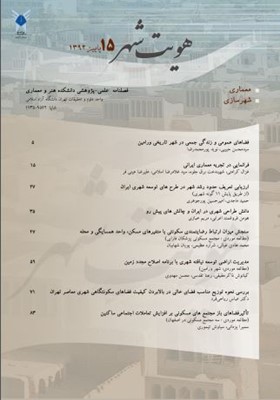فرانمایی در تجربه معماری ایرانی
محورهای موضوعی : معماری
غزال کرامتی
1
*
![]() ,
شهیندخت برق جلوه
2
,
سید غلامرضا اسلامی
3
,
علیرضا عینی فر
4
,
شهیندخت برق جلوه
2
,
سید غلامرضا اسلامی
3
,
علیرضا عینی فر
4
1 - دانش آموخته دکترای معماری دانشکده هنر و معماری دانشگاه آزاد اسلامی واحد علوم و تحقیقات تهران، ایران
2 - استادیار پژوهشکده علوم محیطی، دانشگاه شهید بهشتی، تهران، ایران
3 - دانشیار دانشکده معماری، پردیس هنرهای زیبا، دانشگاه تهران، ایران
4 - استاد دانشکده معماری، پردیس هنرهای زیبا، دانشگاه تهران، ایران
کلید واژه: فرانمایی, فضای ساخته شده, متن, دستمایه های طراحی, فضای نرم و سخت,
چکیده مقاله :
جستجوی علت برقراری ارتباط احساسی فضاهای به جا مانده از تجربه معماری ایرانی با مخاطبان امروزی موضوع این مقاله است. پرسش این است که آیا تجربه معماری ایرانی تجربه ای بیانگر ( فرانمودی) است؟ آیا معماران اغلب گمنام ایرانی هنرمندانی بوده اند که با بیان احساس در قالب فضای ساخته شده با انسان ها به گفتگو نشسته اند، یا فقط مهندسانی بوده اند که روش های برپایی سازه ها و لزوم یگانگی شکل و سازه و کارکرد را خوب می دانسته اند؟ مقایسه تجربه معماران مؤلف امروزی با تجربه معماری ایرانی و تحلیل کیفی آنها به کمک نمونه ایده آل فضای معمارانه، نشان می دهد ایشان در حرکت از فن ایجاد فضای ساخته شده تا برقراری ارتباط معنایی با انسان ها از یک مسیر عبور کرده اند و در طراحی فضای زندگی بینشی عام بر روش کارشان بر گوهرِ فضا حاکم است که بی زمان و بی مکان است.
Expression in Iranian architecture experience is the main point of this article. Today, the spaces remaining from this forgotten architecture make emotional connections with people. Observation of contemporary architectural experiences and their formal specialties shows that being powerful to make emotional connections between the built space and the man is the common ability of stylist architects. Now, in comparison with expressive contemporary masterpieces in the world of architecture, the purpose of this article is to prove that the Iranian architecture experience is an expressive one and unknown Iranian architects were skillful artists, who used the built space as a mould in order to express feelings and shape dialogue between man and space. They were more than just good building engineers. The qualitative analysis of contemporary architectural experiences shows that making emotional connection is the middle step of the process of architectural design, from engineering level to the level of meaning. In this middle step, architect expresses feelings, as a stylist artist, and he may use the way of mimesis or the method of expression. If he has mimicked, then architecture is volumes of built spaces; it is repeatable. In this way of building, nature is a tool for decorating the scene and man is just spectator of a position. But, if he has expressed feelings, then architecture is emotional; it is a situation which connects man to his life space. Here, nature is essential; light , water, wind, plant, etc have been abstracted from their reality in order to be design materials; and essential form of life space is unique and creative. If architecture is expressive, then it is a language: an order of words and their connections, which is laid beneath the surface of the artwork. As a branch of art, architecture has its own specific mould of expression: an order of things in the linguistic organization of the art of shaping human being's life space. Built space, which is recognized by four walls, a roof and a floor, is the mould of expression in architecture. There are many words in the language of architecture, which come together in this mould, to construct essential form of life space. Stylist architect may use natural words, artificial ones or a mixed of the two. Therefore, three types of essential form of space can be recognized. The ideal type of an architectural space is the one that its effect of expression occurs as a soft and hard space. Wall, roof and floor are hard materials and light, water, wind, plant, etc are the soft ones. The resultant is a life space which is as soft as hard is. It is flexible and lets the man to obtain the daily motion of the universe in his built living area. It means: in this way of design, the essential form of space follows lifestyle. Iranian architecture is an artistic experience with expressive effects . Five essential forms of this architecture are: Iranian gardens, palaces, houses, mosques and bazaar complex and elements of urban architecture.
_||_

